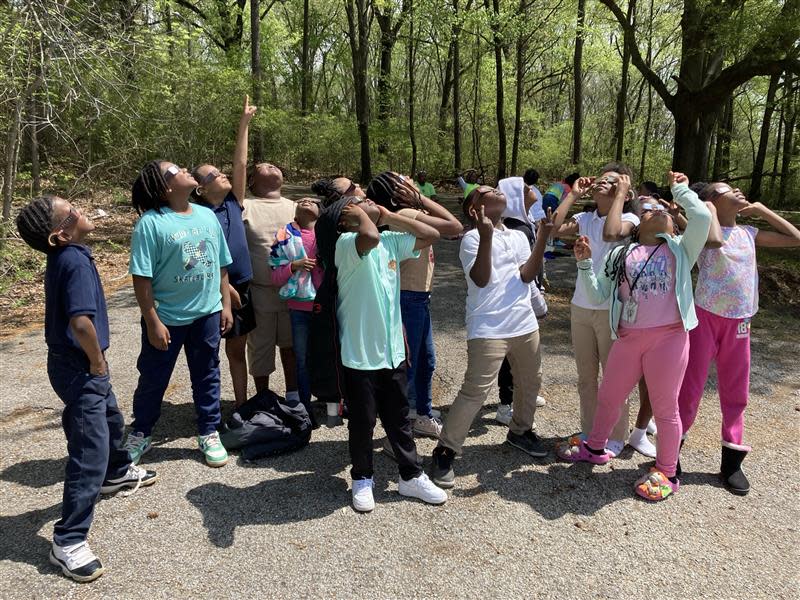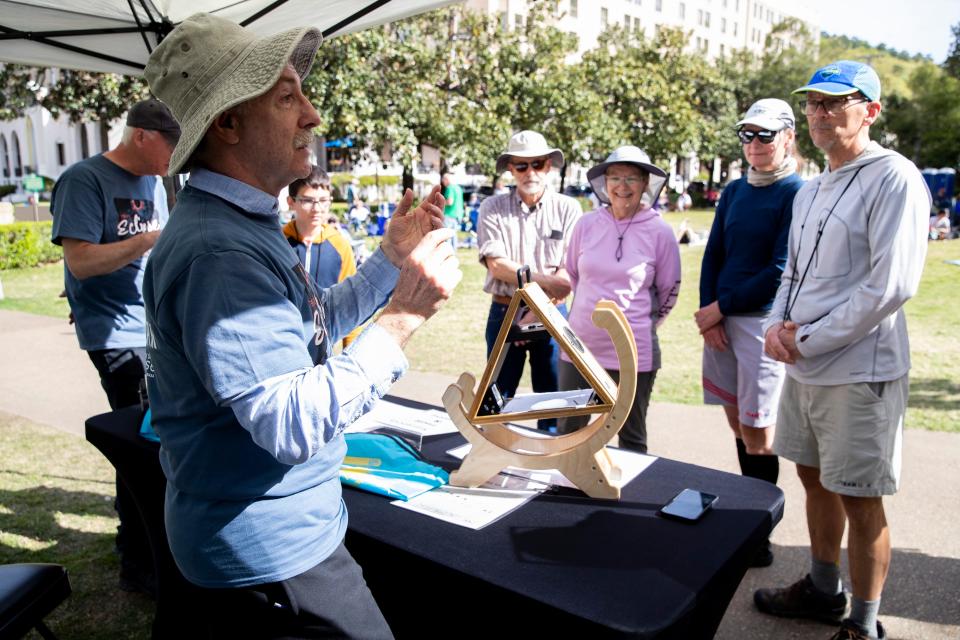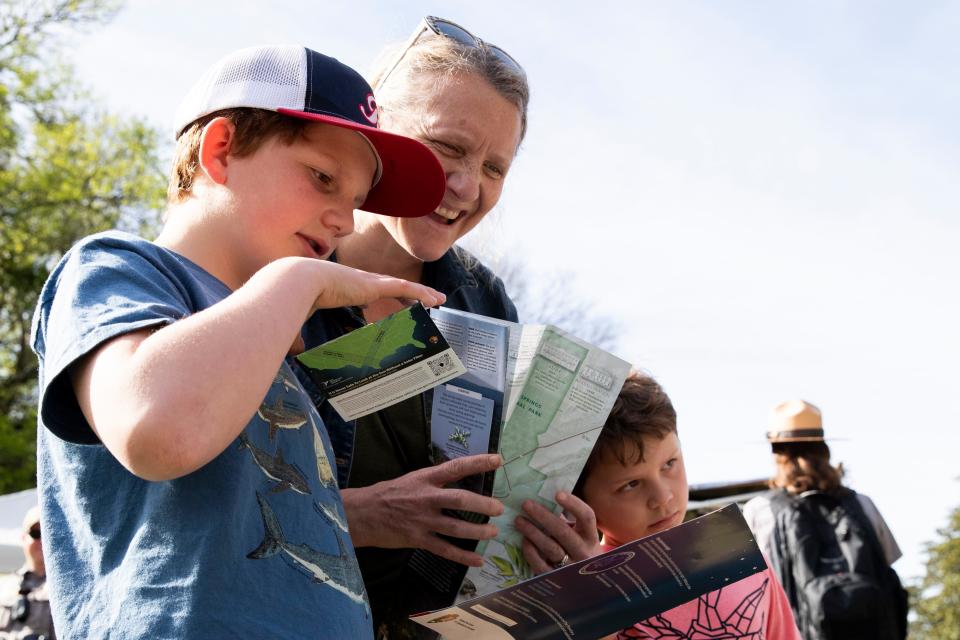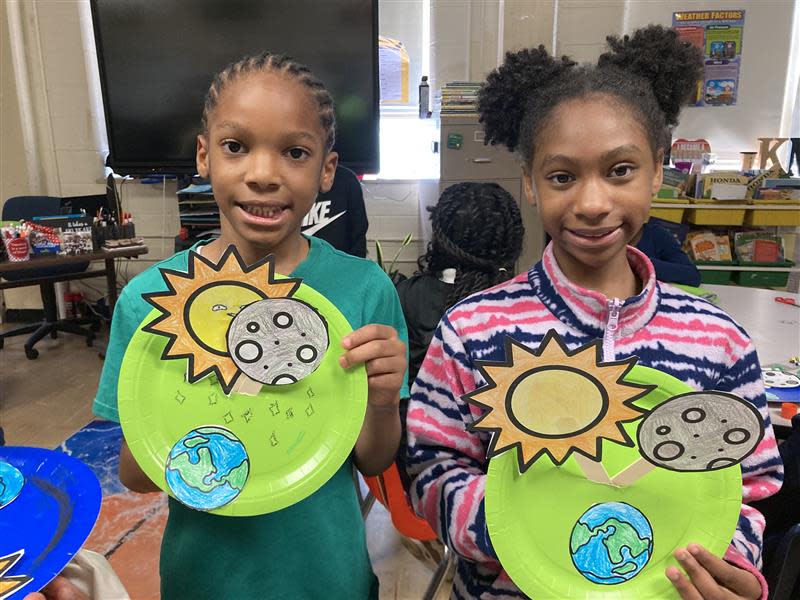Memphis to Little Rock to Hot Springs: How people experienced the total solar eclipse
For a few minutes, around 2 p.m. Monday, life in the Mid-South seemed to stand still.
Along the Mississippi River and in Overton Park, at the Memphis Botanic Gardens and the Memphis Zoo, thousands gathered together and turned their eyes skyward to witness what had been dubbed “The Great American Eclipse.”
The Memphis area saw a partial eclipse for about 2 and a half hours Monday. At the peak, almost 98% of the sun was obscured by the moon. In Memphis, the peak of the eclipse, around 2 p.m., lasted only a few minutes. Just a little bit west, eclipse watchers saw an even more impressive sight. And it made an impression.
"I'm really excited. I feel like a kid now, and I'm 51," said Monica Mackey-Walker, of Jacksonville, Arkansas, who traveled to Little Rock to see the eclipse.
Kendra Barat, a park ranger at Hot Springs National Park, said one of the most exciting things about the eclipse is how people who experience it have a collective feeling of awe and leave happy.

That was on display in Little Rock for Evelyn Holsten, 10, who remarked to a friend "the next time we see this, we're going to be like, 54."
"I think it was pretty cool. It was my first time seeing it and I made a new friend," she said of the eclipse.
Monday’s spectacle was unique and while it won't be 44 years until the next eclipse, it will be a long time. The next visible total solar eclipse to cross over the U.S. will come in more than two decades on Aug. 23, 2044, according to NASA.
That eclipse will begin in Greenland, sweep through Canada and end around sunset in Montana, North Dakota and South Dakota.
But another eclipse on Saturday, Aug. 12, 2045, will trace a path of totality over California, Nevada, Utah, Colorado, New Mexico, Oklahoma, Kansas, Texas, Arkansas, Missouri, Mississippi, Louisiana, Alabama, Florida and Georgia.
Sunny skies, clear roads in Arkansas
In Hot Springs, Arkansas, thousands flocked to the town of 38,000, directly in the path of totality, to take in the celestial spectacle.
Hot Springs National Park Public Information Officer Ashley Waymouth said that park rangers have been actively planning for the crowds and masses of people for about a year.
"A year's worth of meetings, prep work, staff trainings, you know, just a lot of things went into making sure that we could be ready for all of the crowds and for all of the outreach and education that we wanted to do this weekend," Waymouth said.
Dustin Roberts and Faith Kjosa traveled to Hot Springs from Colorado Springs, Colorado. The two began setting up their high-tech photography equipment, which automatically followed the sun through the eclipse and took photos, hours before it started.
The duo watched the annular eclipse in Utah in October, and it inspired them to purchase a star tracker piece for his camera for this year’s total eclipse.
Watching the eclipse in Little Rock, Kate Christian and Quinton Kulka said they came in from Chicago. They had been planning to travel to Arkansas specifically for the eclipse since 2017 and would be going home Tuesday.
Despite the crowds that flocked to all parts of Arkansas ― a large swath of which was in the path of totality ― Dave Parker, a representative from the Arkansas Department of Transportation, said that traffic in the state was “flowing extremely well,” with only one major highway accident as of mid-day.

The department’s predictions of a slow build in traffic leading up to Monday were spot on. Counts from the day before the eclipse showed a 10% increase in traffic over a typical Sunday.
Many of the people coming to Arkansas made last-minute day trips, he said. Parker said Monday morning forecasts predicting clouds and rain in nearby regions likely contributed to more people driving to Arkansas day-of.
A National Weather Service briefing indicated that a 150-mile stretch around Little Rock would have some of the best visibility along the entire path of totality in the U.S.
“The unknown is still out there as to, once it’s over, what people do,” Parker added.

Monday morning he said he expected many people driving long distances from out of state will have learned the lesson of the last eclipse and will stay longer in Arkansas to avoid the “major traffic jams.”
“That’s a win for everyone,” Parker added.
'A bite out of a cookie'
Back in the Memphis area, watch parties abounded, from workplace gatherings to class activities to large public gatherings.
Terry Balton, a regular and enthusiastic Memphis Zoo patron was visiting the flamingos as the moon ticked towards eclipse totality. The flamingos strutted around their enclosure, most of them with their heads pointed towards the sky, as though they were looking at the celestial event.
“You have to wonder if that’s what they’re looking at,” said Balton.

A zookeeper materialized to Balton’s right.
“Oh, that’s mating behavior. They don’t know what’s going on,” the zookeeper said.
Animal behavior aside, the zoo was bustling Monday with humans who were behaving differently, namely by walking around with solar eclipse glasses on, necks stretched upwards and mouths open as the sunlight grew dim.
Employees at the Crye-Leike Realty office on Forest Hill Irene Road in Germantown gathered in the parking lot outside Monday afternoon to take in the eclipse. They said they started their watch party around 1 p.m.
A third-grade science class at Scenic Hills Elementary prepared for the eclipse with an art exercise involving a cutout sun, moon, and earth attached to a paper plate. The sun and moon are glued to popsicle sticks and can be shifted back and forth.
Monday morning, students in the class said they understood what caused the eclipse and said they were excited to see it. Some also wondered if the darkening of the sky would cause nocturnal animals to become animated.

As the eclipse started, students headed outside, donned their special glasses and stared into the sky, shouting, “I see it! I see it!” Others laid back on blankets, like they were sunbathing, to take in the view.
"It's like a baby took a bite out of a honey bun," a student said.
“It looks like someone took a bite out of a cookie,” another commented.
And perhaps the most succinct of all: "It looks like a banana."
Mark Russell and USA Today contributed to this report.
This article originally appeared on Memphis Commercial Appeal: What people thought of 2024 solar eclipse in Arkansas, Tennessee
